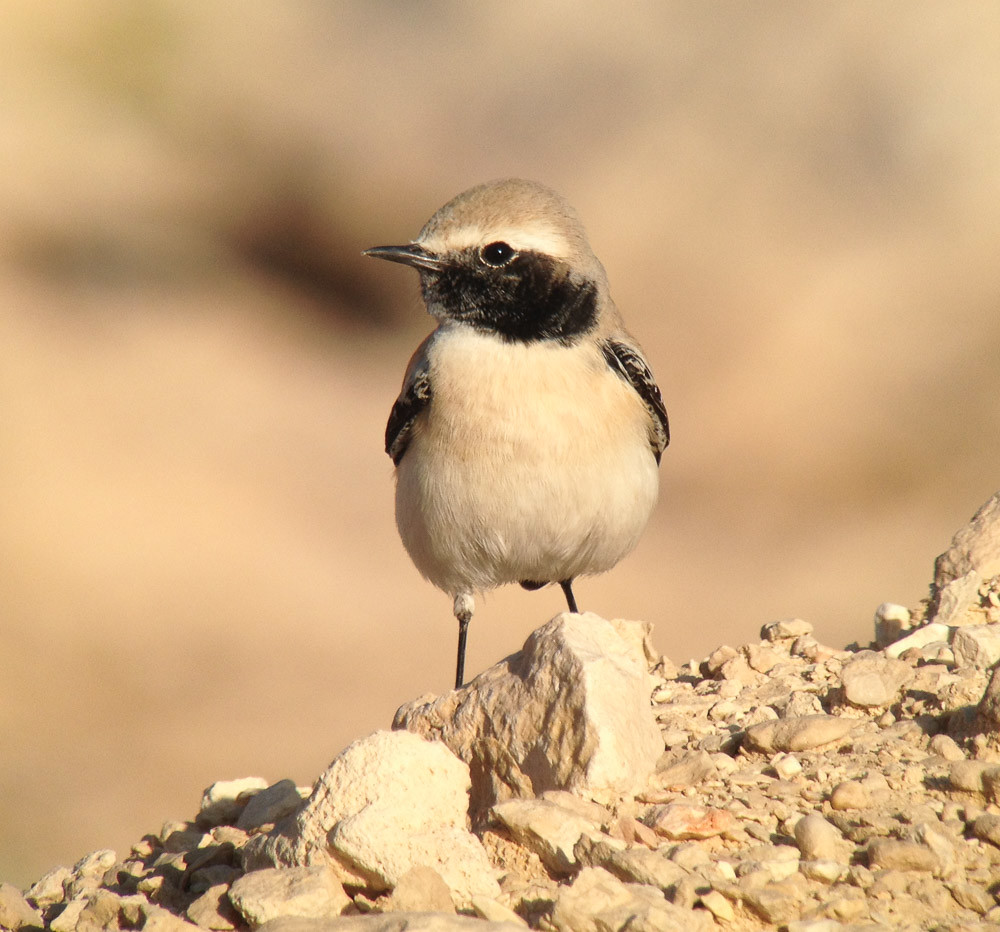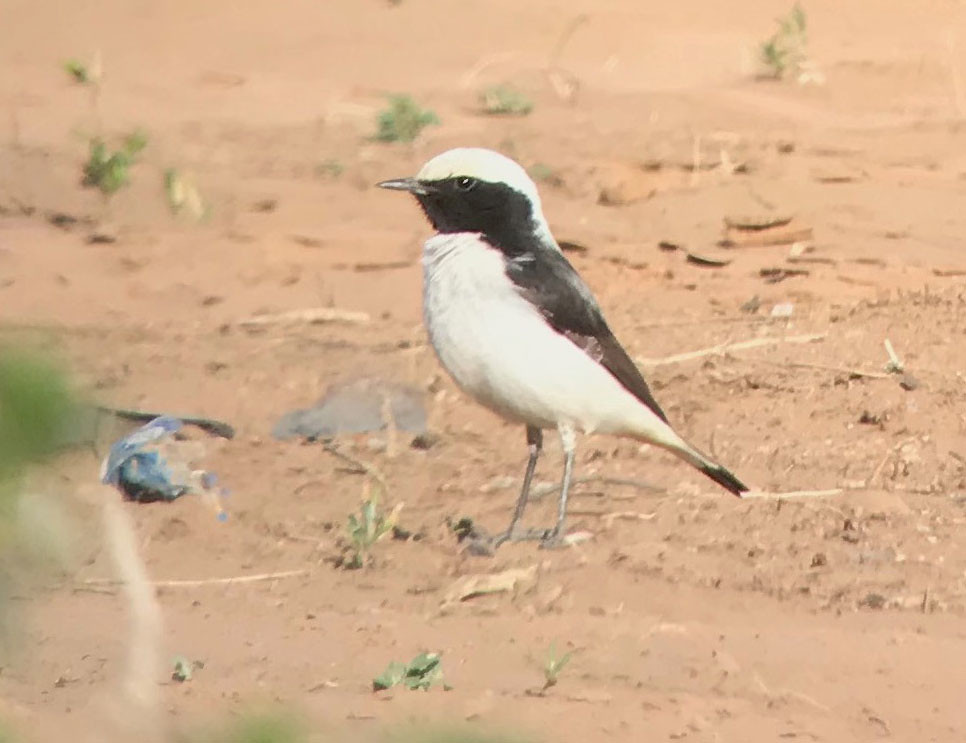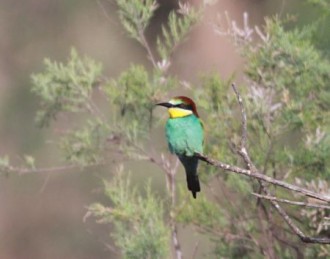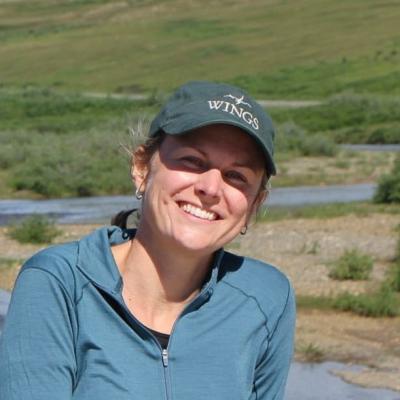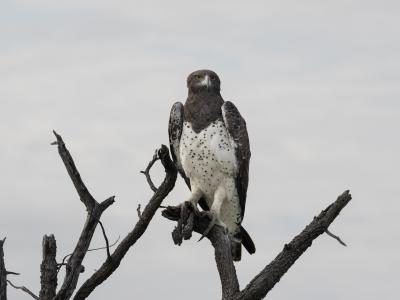Morocco in Spring
-
Mar 22 to Apr 2 2025
Ethan Kistler
-
Mar - Apr, 2026
Ethan Kistler
2026 Tour Price to be Determined
2026 Tour Price to be Determined
As early spring touches Morocco, the country bursts into life, offering the visiting birdwatcher some truly memorable experiences. We’ll begin in Marrakech before heading into the dramatic mountains of the High Atlas. Here we’ll seek out a variety of mountain birds, and in particular the elusive African Crimson-winged Finch, a species that is probably seen more easily here than anywhere else.
Perhaps most exciting of all will be our trip through the desert areas near Boumalne Dades and Merzouga along the edge of the spectacular Sahara. In this beautiful landscape are more special birds, including such classic desert species of North Africa as Cream-colored Courser, Thick-billed Lark, and Desert Sparrow. We’ll then travel down to the Atlantic coast and Agadir, where we hope to find Northern Bald Ibis, one of the world’s rarest birds, as well as a variety of waterbirds on the Souss and Massa estuaries.
Day 1: The tour begins this evening in Marrakech.
The tour was great and Ethan was a fantastic guide. The scenery and birds were both awesome! This tour takes you through a variety of landscapes that amaze at every turn. - Amanda B.
Days 2-3: From Marrakech we’ll drive south to the Atlas mountains where we have two days exploring this wonderful area. African Crimson-winged Finch is our primary goal, often found amongst flogs of Rock Sparrows and ‘Atlas’ Horned Larks (a potential split). We’ll also see African Blue Tit and ‘North African’ Chaffinch and (the latter already regarded by many authorities as a full species).
The three countries of Morocco, Tunisia and Algeria make up the Maghreb, and this area has several endemic species/subspecies depending on whose taxonomy you follow. With luck this mountainous terrain will provide us with two of these—Moussier’s Redstart and Atlas Wheatear. The high meadows, sometimes covered in snow even in April, are home to both Yellow-billed and Red-billed Choughs, and Water Pipit and White-throated Dipper may be found nearby. Overhead we may see the local ‘Atlas’ race of Long-legged Buzzards and, having now recovered from years of persecution, perhaps a mighty Lammergeier. Nights near Oukaimeden.
Day 4: After an early breakfast we’ll leave the mountains behind, perhaps pausing en route for Levaillant’s Woodpecker. From the flat plains of Marrakech we’ll turn back uphill and make the long, scenic drive to Boumalne via the spectacular Tizi-N’Tichka Pass. As the road climbs into the hills, we may start to see some more raptors, possibly including migrant Booted Eagle and Short-toed Snake Eagles. Before lunch we’ll target another North African endemic, Tristram’s Warbler. If time allows, we’ll make a stop in Ouarzazate to explore the dam at Mansour Edhabbi. Here we’ll have a chance of seeing Blue-cheeked Bee-eater, Eastern Olivaceous Warbler and Maghreb Lark, as well as Ruddy Shelduck, Marbled Duck, Eurasian Spoonbill, and a selection of waders and migrants. Night in Boumalne Dades.
Day 5: We’ll head out before breakfast to explore the famous Tagdilt region. Our targets for the day will include Black-bellied Sandgrouse, Cream-colored Courser, Desert and Red-rumped Wheatears, Trumpeter Finch, and a selection of larks including Greater Hoopoe, Temminck’s, both Greater and Mediterranean Short-toed, and with luck the highly nomadic Thick-billed. At this time of year migration is often evident over the desert as small groups of European Bee-eaters and swifts (both Pallid and Common) work their way north. Night in Boumalne Dades.
Day 6: The scenery will change again today as we leave behind the high, stony desert and travel to a sandier habitat. New birds will continue to appear, with Brown-necked Raven, Bar-tailed Lark, Scrub Warbler, and White-crowned Wheatear all possible. If we’re lucky, we may be able to catch up with Maghreb Wheatear, Pharoah Eagle Owl and Lanner Falcon en route. After passing the dramatic Ziz Gorge with its unexpected palm-lined valley, we’ll make our way to Erfoud, the gateway to the Sahara. On the edge of the desert, we could see a selection of migrant warblers around the hotel, ranging from Western Subalpine and Sardinian to Western Bonelli’s and Western Olivaceous, as well as Eurasian Wryneck, Hoopoe, Bluethroat, Woodchat Shrike, and European Bee-eater. The highly localized Eastern Olivaceous Warbler (race reiseri) sometimes breeds near the hotel. Night in Erfoud.
Day 7: We’ll spend the whole day in four-wheel-drive vehicles exploring this fascinating desert habitat. We’ll be searching for a number of classic desert birds including Desert Sparrow, Bar-tailed and Greater Hoopoe Larks, Spotted and Crowned Sandgrouse, Cream-colored Courser, Desert Grey Shrike, and African Desert Warbler. We’ll also have another chance of catching up with Lanner Falcon and Pharoah Eagle Owl is a real possibility. We also hope to find a beautifully camouflaged Egyptian Nightjar at a daytime roost. Night in Erfoud.
Day 8: We’ll have another long journey today, but not without some birding along the way. Blue-cheeked Bee-eaters are often seen along the route, and we’ll stop at likely looking spots to check for migrants. After another picnic lunch we’ll continue to Ouarzazate where, depending on our arrival time, we may be able to check out the shoreline of the nearby reservoir or bird some of the lush green gardens along the river. Night in Ouarzazate.
Day 9: There will be more time this morning for birding around the reservoir. In recent years this has been a reliable site for Ruddy Shelduck, and migrant waders could include Wood and Curlew Sandpipers, Ruff, Little Stint, and Black-winged Stilt. Passerines will also be present, and careful checking through groups of Yellow Wagtails could produce three different subspecies as well as the Moroccan White Wagtail—species or not, the latter is a stunning bird to see. Migrant harriers often drift through, with Montagu’s and Western Marsh the most likely, and we may see Greater Flamingo and Black-crowned Night and Purple Herons. Our destination this evening is coastal Agadir, and once away from the reservoir we’ll drive through more mountainous habitat, home to Bonelli’s Eagle, Black Wheatear, and Western Orphean Warbler, stopping in Tazenahkt for a coffee break and the chance to haggle for a carpet to take back home from Morocco’s ‘carpet city’. Night in Agadir.
Day 10: Driving alongside long Atlantic rollers, we’ll head north of Agadir in search of one of Morocco’s most iconic birds, the Northern Bald Ibis. At this time of the year, visiting the breeding cliffs of this endangered species is quite rightly not allowed, but we may find them in coastal fields, where they can sometimes be very confiding. At nearby Tamri we’ll check the estuary, where the ibis sometimes drop in to bathe, as do hundreds of gulls, often including the increasingly numerous Audouin’s and Slender-billed. If there is an onshore wind, seawatching may produce Northern Gannet, Cory’s Shearwater, and occasionally a skua or even a Razorbill. Migrants may include Western Black-eared Wheatear, Tawny Pipit, and Eurasian Thick-knee, while European Serin, Zitting Cisticola, and House Bunting are all common breeders. We’ll spend the afternoon around the Souss estuary, where anything can, and frequently does, turn up. Large wading birds such as Greater Flamingo, Eurasian Spoonbill, and White Stork can be numerous, and we’ll check the gulls and terns for species such as Mediterranean Gull and Gull-billed and Caspian Terns. Waders are often plentiful and the selection ever-changing, from both Bar-tailed and Black-tailed Godwits to Eurasian Greenshank, Black-bellied and Kentish Plovers, and Little Stint. The nearby scrub holds plenty of Maghreb Magpies as well as a special bird widespread throughout Africa south of the Sahara, the striking Black-crowned Tchagra. Night in Agadir.
Day 11: Just as famous as the Souss estuary is the Oued Massa, about an hour south of Agadir. Here the dry stone walls provide ideal perches for Little Owls, Thekla Larks, and wheatears, and the neatly farmed agricultural areas are excellent for Laughing Doves and European Turtle Doves, as well as Barbary Partridge, “Sahara” Great Grey Shrike, Moussier’s Redstart, and Cirl Bunting. The once brackish lagoon inland of the dunes can hold a variety of waders and herons, and walking along its length provides a great opportunity to scan for raptors, with Osprey, Bonelli’s Eagle, and Black-winged Kite all possible. After lunch we’ll explore more agricultural areas inland where we may find Little Bittern, Squacco and Purple Herons, and Brown-throated Martin, the latter at one of its few Western Palearctic locations. Night in Agadir.
Day 12: The tour concludes this morning at the airport in Agadir.
Note: The information presented here is an abbreviated version of our formal General Information for this tour. Its purpose is solely to give readers a sense of what might be involved if they take this tour. Although we do our best to make sure that what follows here is completely accurate, it should not be used as a replacement for the formal document which will be sent to all tour registrants, and whose contents supersedes any information contained here.
ENTERING MOROCCO: Travelers to Morocco must have a passport valid at the time of entry and with at least one bank page for an entry stamp. Visas are not required for American tourists traveling in Morocco for less than 90 days. For further information on entry requirements for Morocco, please contact the Embassy of the Kingdom of Morocco in the United States: https://us.diplomatie.ma/
COUNTRY INFORMATION: You can review the U.S. Department of State Country Specific Travel Information here: https://travel.state.gov/content/travel.html and the CIA World Factbook here: https://www.cia.gov/the-world-factbook/. Review foreign travel advice from the UK government here: https://www.gov.uk/foreign-travel-advice and travel advice and advisories from the Government of Canada here: https://travel.gc.ca/travelling/advisories.
PACE OF TOUR AND DAILY ROUTINE: Typically we drive to various locations and make fairly short and slow walks from the vehicle. There are several longer strolls (two hours or so). There are a few longer drives (on a couple of days much of the day is spent travelling) but the scenery is always changing and there will be birding stops as and when we see anything of interest. Breakfasts are usually around 7:00 a.m. and are often very simple with coffee, juice, bread and jam. There may be an early start where we return to our hotel for a late breakfast. On some days lunch will be a picnic at a birding site.
HEALTH: The Centers for Disease Control and Prevention (CDC) recommends that all travelers be up to date on routine vaccinations. These include measles-mumps-rubella (MMR) vaccine, diphtheria-tetanus-pertussis vaccine, varicella (chickenpox) vaccine, polio vaccine, and your yearly flu shot.
They further recommend that most travelers have protection against Hepatitis A and Typhoid.
The most current information about travelers’ health recommendations can be found on the CDC’s Travel Health website at https://wwwnc.cdc.gov/travel/destinations/list
Elevation: We reach 2,600m (8,500 feet) in the Atlas Mountains of northern Morocco. The walking here is not strenuous and mostly on level ground. We reach similar altitudes driving over the Tiz N’Tichka pass. The Sahara Desert is a relatively high desert at around 900m asl (3,200 feet) and we’ll spend several days at this altitude, where the weather can be surprisingly chilly in the very early morning.
Miscellaneous: Mild intestinal disorders are difficult to avoid completely and we suggest that you bring diarrhea medication such as Imodium. Water in Morocco is generally safe in the larger towns but we would recommend that you do not drink tap water, or eat salad anywhere on the tour. As an extra precaution, the leaders even use bottled mineral water for teeth-brushing etc. Bottled water, beer and soft drinks are widely available.
We are unlikely to encounter mosquitoes or biting insects except at the Souss estuary, and some of the desert oases and lakes are as much a magnet for insects as they are for birds.
CLIMATE: It is generally warm to hot and dry throughout the year but in spring it can be cooler in the north and very cold in the mountains and desert areas. Temperatures range from 10-15°C (50-60°F) at night to daytime highs of 15-30°C (60-90°F) in lowland areas. In the mountains temperatures are usually 5-10°C (10-20°F) lower but even in March it can be below freezing for most of the day at the ski resort. Rainfall is low in the desert (a shower every four years or so) but moderate in the Atlas (whereas at this time of year it may still fall as snow) and along the coast. We may experience some windy days especially in the mountains and desert which can make an otherwise warm day seem very cold.
ACCOMMODATION: Our hotels are all comfortable, modern hotels with Wi-Fi and en suite facilities.
FOOD: Breakfast usually consists of a simple selection of bread, eggs, jam, orange juice, tea and coffee. Lunch will either be a picnic with fresh bread, cheese, tinned tuna, plus lots of local fruit, olives, cucumber, tomatoes and onions, or we will stop in cafes, offering tajines, brochettes or omelettes, and hopefully on the coast some very fresh seafood. Dinners are often excellent, ranging from tajines of chicken, lemon and olive; or lamb, prune and almond to couscous with lots of local vegetables. In the more touristy areas there will likely be a large dinner buffet.
Drinks: Bottled water and a soft drink or a beer is provided at lunch and dinner, as is coffee or tea. All other drinks or ‘personal’ drinking water for use in your room is the responsibility of the individual. Bottled water is provided in the tour vehicles during the day.
Food Allergies / Requirements: We cannot guarantee that all food allergies can be accommodated at every destination. Participants with significant food allergies or special dietary requirements should bring appropriate foods with them for those times when their needs cannot be met. Announced meal times are always approximate depending on how the day unfolds. Participants who need to eat according to a fixed schedule should bring supplemental food. Please contact the WINGS office if you have any questions.
TRANSPORTATION: The transport for the tour will be by minibus or small coach. On one day in the desert we will transfer to 4x4’s. We will not cover large distances in these vehicles but they are essential to reach some of the key birding sites. Participants should be willing and able to ride in any seat in the tour vehicles.
2023 Narrative
From snow-capped mountains to towering sand dunes, coastal estuaries and palm-lined river courses, Morocco is magically beautiful. The tour began in the Atlas Mountains where we found all of our major targets including Crimson-winged Finch, Levaillant’s Woodpecker, “Atlas” Horned Lark, Barbary Partridge and Moussier’s Redstart. In the gravel plans around Boumalne Dades, we enjoyed various larks including Temminck’s, Thick-billed, and Greater Hoopoe-Larks, Cream-colored Coursers, and Trumpeter Finches, while the scenic gorge above town gave us Tristram’s Warbler and Bonelli’s Eagle. The desert around Merzouga didn’t disappoint with excellent views of sandgrouse, Desert Sparrow, Fulvous Chatterer and two Egyptian Nightjars. The tour concluded around the coastal city of Agadir, where we had a whole host of waterfowl, waders, shorebirds, gulls, and even Razorbills. Of course, the main attraction was the Critically Endangered Northern Bald Ibis, which we had wonderful views of. It’s no wonder Morocco is such an admired birding destination!
The tour began in Marrakech and after an hour-long drive through towns and farmlands, passing Maghreb Magpies and Spotless Starlings along the way, we reached the Atlas Mountains. The road twisted and turned offering majestic views of terraced slopes brightened with flowering almond trees and snow-capped mountains towering above.
Our birding began at Vallée d’Oukaïmeden, a small ski town, where large mixed flocks of Red-billed and Yellow-billed Choughs welcomed us along the road and Rock Sparrows singing from every other building. We began wandering around on foot, quickly finding a mixed flock of Brambling and the North African subspecies of Common Chaffinch. Among the chaffinches was a single male from the European populations, a rarity here. Nearby we had Black Redstart, the delightful Moussier’s Redstart, and the “Atlas” subspecies of the Horned Lark. We returned and drove up to some higher terrain and cliffs where we added “Atlas” Long-legged Buzzard, Blue Rock-Thrush, Rock Bunting, and a “Barbary” Falcon, which is split by some checklist authorities. Back in town at our lunch stop, African Blue Tits greeted us on the railings and “wild type” Rock Pigeons circled above. Before heading a little way down the mountain toward our accommodation, we walked along a gorge with a running creek. Here we managed to Gray Wagtail and a pair of White-throated Dippers after a bit of searching. They cooperated very well as they both sat right next to each other under a large boulder, remaining even after we left.
Early evening, we walked around our accommodation, which is situated in a beautiful valley with a coniferous forest, running creek, and terraced gardens. Along the vegetated stream we had a Cetti’s Warbler, European Serin, several Mistle Thrushes, Cirl Bunting, and a Eurasian Blackcap. The forest provided all species of tits including our first Coal and Great along with a Hawfinch, which remained hidden. We also had a couple “North Africa” Red Crossbills, which remained elusive, but would end up being seen very well later on. After dinner we managed to hear a Maghreb Owl.
The next morning, we headed back up the mountain to try our luck for the “African” Crimson-winged Finch. While loading the vehicle, we had two Eurasian Jays calling in the pines above. The moment we arrived, we were greeted by 11 Crimson-winged Finches before we even left the vehicle. We spent the rest of the morning birding around the area, picking up a few new species including Sardinian Warbler, a flock of five Ring Ouzels, a pair of Atlas Wheatears, and a surprise Common Snipe, which seemed very out of place.
Next on our itinerary was a pine plantation, which offered our first Great Spotted Woodpecker, Common Firecrest, and cryptic Short-toed Treecreeper. Back at our accommodation we added Western Olivaceous Warbler. After a mid-day break, we headed down the road a bit to a small village where we quickly found a Levaillant’s Woodpecker, which put on an excellent show for everyone as it was unperturbed by our presence. While watching this North African endemic, we had views of a Eurasian Wren and European Robin.
The next morning, we packed up and departed with four “North African” Red Crossbills in the carpark giving us better views than before. We headed back down the mountain to the Ourika Valley where we scanned open farmlands which provided Thekla’s Lark, European Stonechat, Corn Bunting, and four Barbary Partridges. We began our journey over the Atlas Mountains through the Tizi N’Tichka Pass making several stops along the way. A large forest patch added Woodchat Shrike, Western Black-eared Wheatear, and a surprise Eurasian Griffon – the first one reported in Morocco this year and a tour first! We had an excellent lunch along the way eventually arriving in Boumalne Dades, our base for the next two nights. After dinner, we headed to an area nearby where Eurasian Scops-Owls were already calling. With very little effort, we eventually had superb views of one offering excellent photographic opportunities.
On the edge of Boumalne Dades is a productive and vast desert plain; this is where we spent the morning birding, along the “Tagdilt Track”. Our first birds upon arrival were small groups of Temminck’s and Greater Short-toed Larks followed by Desert and Northern Wheatears and a pair of Trumpeter Finches. Moving on to an area that is productive for Greater Hoopoe-Lark, we walked a loop picking up Cream-colored Courser, flocks of Black-bellied Sandgrouse, and a surprise Black Stork catching thermals above. After a while, we found a hoopoe-lark, which entertained us for quite a while calling and doing its acrobatic display. This ended up being one of the most popular birds and experiences of the trip!
We then checked a nearby farm which often holds migrants and had our first Eurasian Hoopoe, Common -Redstart and Eurasian Linnet, before heading into town for some tagines at one of the trip-favorite restaurants picking up a half dozen Red-rumped Wheatears along the way. After lunch, we headed into the Dades Gorge in search of the Tristram’s Warbler. Along the way we spotted our first of several Bonelli’s Eagles soaring near some cliffs. We eventually made it to the Tristram’s Warbler location and spent a while searching. Despite the large VW Golf Challenge rally, we were able to find a male that popped up briefly right along the road. Before dinner we headed to the nearby Dades River and birded the gardens where we had European Bee-eater, Western Subalpine Warbler, Common Nightingale, European Greenfinch, and European Goldfinch among others.
We headed back to the Dades River the next morning and walked around for an hour, adding more to our trip list with the likes of European Turtle-Dove, Western Yellow Wagtail, and Meadow Pipit. Afterwards, we headed to the landfill where we had excellent views of four Thick-billed Larks, who seemingly enjoying their surroundings. Outside Boumalne Dades, we visited an escarpment which hosts breeding Pharoah Eagle-Owls. Two Desert Larks, a migrant Whinchat, and breeding Booted Eagle later, we scoped the eagle-owl nest and observed one actively incubating. Just as we were about to leave, a “Maghreb” Mourning Wheatear popped up on top of a bush to sing farewell. Further east we stopped and birded a scrub area along the road where we eventually found a Scrub Warbler, which entertained us as it distinctively hopped around on the ground like a mouse. We also added Spectacled Warbler and Bar-tailed Lark before hitting the road and driving to Merzouga for the next two nights.
Switching to 4x4s the following morning we explored the desert around the towering Erg Chebbi sand dunes. First on the agenda was to catch the sandgrouse coming in to drink during the morning hours. We were not disappointed with no fewer than a couple hundred Spotted and Crowned Sandgrouse. We then visited a home of a Berber family, where they put out water and food for the Desert Sparrow. After a few minutes, a pair arrived and provided excellent views for the group. Also present were a couple White-crowned Wheatears and several Greater Hoopoe-Larks, including one fearless individual feeding only a few yards in front of us. Birding some nearby scattered shrubs, we picked up several Bar-tailed Larks and an African Desert Warbler before we headed to a stakeout Golden Nightjar. When the local Berber showed us the way to his scouted location, we were surprised to find a pair sitting together! After a local lunch in the town of Rissani, we headed to a nearby wastewater treatment plant. In the tamarisk we had several Eastern Olivaceous Warblers, Blue-cheeked Bee-eaters, and Willow Warbler while the ponds held Ruddy Shelduck, Black-winged Stilt, Little Ringed Plover, and Common Sandpiper. The rest of the afternoon was spent searching for Fulvous Babbler, which gave us a run for our money, but we eventually found several, with one teeing up for good scope views. We also enjoyed “Maghreb” Larks, a recent lump with Crested Lark.
The next morning we checked a palm grove near our hotel where we added a couple Eurasian Wrynecks before retracing our footsteps towards Ouarzazate. Although a travel day, we made a stop at the Ouarzazate Dam, which was pretty quiet, but still provided Great Crested Grebe, Mallard, and Gray Heron.
The next day was our final long travel day as we worked our way towards the coast and the city of Agadir. Before departing, we took a leisurely walk behind our accommodation in an area of farmlands and greenery where we had a surprise Common Grasshopper Warbler, a scarce migrant in Morocco. Outside of town, a small dam added Pallid and Common Swifts, Green Sandpiper, and Common Greenshank. A stop along the Drâa River held Sedge Warbler, Bank Swallow, Greater Whitethroat, another Bonelli’s Eagle, and several dozen Western Yellow Wagtails of several subspecies. After a lunch stop, we paid a visit to a local saffron cooperative where we were given a short presentation about the cultivation; most of us purchased some to take home. A couple stops before reaching Agadir, we managed to pick up Rufous-tailed Scrub-Robin and Western Orphean Warbler.
The final two days we focused on the coastal region around Agadir with this morning concentrating our time north of town. Our first stop was an area where Northern Bald Ibis often feed, and we eventually tallied 18 individuals. We enjoyed from a respectful distance, but several of them decided to walk even closer to us offering great views.
The Asif n’Srou Estuary was productive with the likes of “Moroccan” Wagtail, Eurasian Marsh Harrier, Eurasian Oystercatcher, and a nice collection of gulls roosting on the beach with Lesser Black-backed, Yellow-legged, and Audouin’s Gull all present. A nearby overlook offered a chance to scan for seabirds and we found a dozen or two Razorbills, countless Northern Gannets, a single Cory’s Shearwater, and a Eurasian Thick-Knee in the parking area. We finished the day off at the mouth of the Oued Souss, where hundreds of shorebirds can be found. Here we found our first Black-bellied, Kentish, and Common Ringed Plovers, Whimbrel, Eurasian Curlew, Bar-tailed Godwit, Curlew Sandpiper, Sanderling, Dunlin, and Common Redshank. We also had Common Shelduck, a single Greater Flamingo, Marbled Teal, Mediterranean Gull, Caspian Tern, Eurasian Spoonbill, and an Osprey to name a few. After dinner we went back out to an area near our hotel and successfully found two Red-necked Nightjars.
Our final day, we headed south of Agadir to the Sous-Massa National Park where we birded along the Massa River. Northern Shoveler, Slender-billed Gull, “Moroccan” Great Cormorant, Purple Heron, and Glossy Ibis were some of the additions while raptors also put on a great show with our first Black-winged Kite, Hen Harrier, and yet another Bonelli’s Eagle. Back at the carpark, a pair of Black-crowned Tchagras put on a great show. After an excellent lunch, one of the favorites of the tour, we birded a few more areas near the Massa River before returning to our hotel for our final dinner together. All in all, it was a very successful tour with all the main targets in the bag and even a couple new birds for the tour.
- Ethan Kistler
Stephen was excellent. Top notch guide, wonderful with all of us on the tour as well as dealing with the logistics with the locals. He was very good about directing his attention equally to all of us.
- Mary G. on Morocco in Spring
Stephen is an exceptional guide, particularly for someone relatively young. He combines superb birding skills (especially by ear) with an impressive ability to manage overall logistics, and problems as they come up.
- Malcolm B. on Morocco in Spring
Ethan was simply superb and we cannot wait to book another tour with him. He has boundless energy, enthusiasm and is extremely attentive to the needs of all participants.
- JC B. on Morocco in Spring
Ethan is an outstanding birder and steward of the environment. Did a lot of preliminary scouting at our destinations before arrival of the group and made some adjustments to the itinerary to make sure everything was in order for the tour. He made an extra effort to look out for COVID-related health concerns, such as getting us to meals early to avoid crowds and looking out for use of masks in appropriate settings. Engaging conversations about his unique experiences in birding and conservation.
- Valerie B. on Morocco in Spring
The tour was great and Ethan was a fantastic guide. The scenery and birds were both awesome! This tour takes you through a variety of landscapes that amaze at every turn.
- Amanda B. on Morocco in Spring
Transfer back to the Marrakech airport from Agadir (where the tour concludes) is available.
Maximum group size 9 with one leader.


















